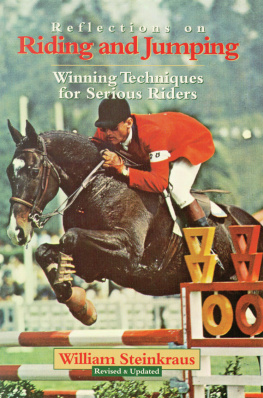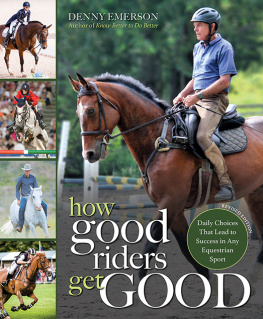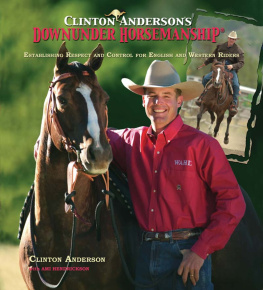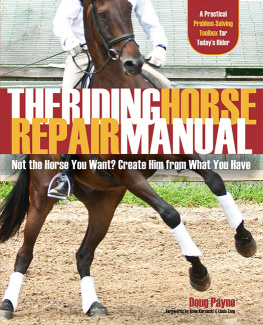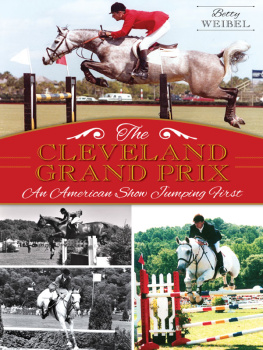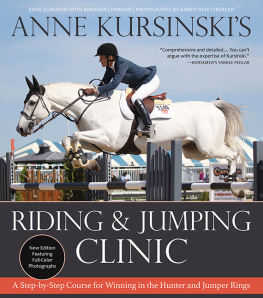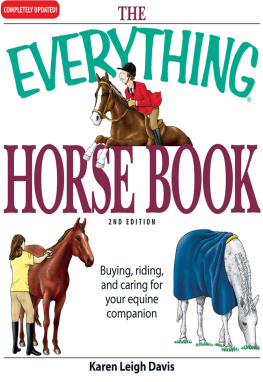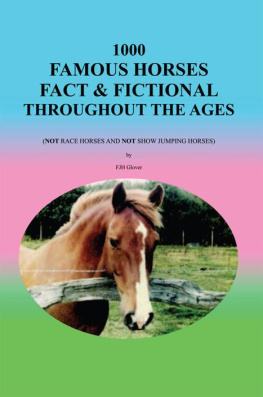Many good horsemen maintain that no matter how long your equestrian career, horses always have something more to teach you. In practice, however, these experts may be less than candid in passing on what they have learned. Thus, equestrian literature is full of books that go only so far: they deal with the basics, but carefully avoid the more difficult, subtle or controversial subjects. Yet once riders are past the beginners stage, these are precisely the areas in which they need guidance if they are to progress to a higher level of skill.
Bill Steinkraus was already an Olympic rider (though not yet a gold medalist) when he wrote his first, highly acclaimed book about riding and jumping, which saw two English editions and several translations. This work covered a lot of basic truths and struck a lot of responsive chords in its readers, but as the author is frank to admit, there were also topics that he avoided at the time because he felt he still lacked the experience to deal with them, or wished to think about them further. Three decades later, he rectified these omissions by writing an entirely new book, Reflections on Riding and Jumping, which, while revisiting some of the same ground covered in his earlier book, also presented a wealth of entirely new material on riding and horsemanship and a completely new selection of instructional photographs and sequences.
Now in this new, revised edition, he has expanded this new material even further, adding an invaluable chapter on how to put it all together and win, plus a collection of his own favorite riding aphorismstwo dozen maxims about horses and riding that are expressed so concisely and so pointedly that they are sure to stick in your mind and help your riding for years to come. All this makes it a book that surely belongs in the library of every serious student of the horse.

Also by William Steinkraus
Riding and Jumping
With M.A. Stoneridge
The Horse in Sport
As Editor
Great Horses of the USET
The Complete Book of Show Jumping
The Encyclopedia of the Horse
The USET Book of Riding

This revised edition published in 1997 by
Trafalgar Square Publishing, North Pomfret, Vermont 05053
First published in 1991 by Doubleday, a division of Bantam Doubleday
Dell Publishing Group, Inc.
Copyright 1991, 1997 by William Steinkraus
All rights reserved. No part of this book may be reproduced, by any means, without permission in writing from the publisher, except by a reviewer who wishes to quote brief excerpts in connection with a review in a magazine or newspaper.
Disclaimer of Liability:
The Author and Publisher shall have neither liability nor responsibility to any person or entity with respect to any loss or damage caused or alleged to be caused directly or indirectly by the information contained in this book. While the book is as accurate as the Author can make it, there may be errors, omissions, and inaccuracies.
Library of Congress Cataloging-in-Publication Data
Steinkraus, William.
Reflections on riding and jumping : winning techniques for serious riders / William Steinkraus ; sequence photographs by Alix Coleman and Peter Winants. New and rev. ed.
p. cm.
Includes bibliographical references and index.
ISBN: 1-57076-043-8
1. Show jumping. 2. Show riding. I. Title
SF295.5.S718 1997
799.23dc20 96-33561
CIP
Cover and book design by Sally Sherman
Printed in the United States of America
10 987654321
This book is gratefully dedicated to the
many people who helped me in my riding career,
and most especially to the memory of my mother
and to my darling wife, without whose sacrifices
my riding career would never have existed.
Acknowledgments
The author would like to acknowledge his appreciation of the generous collaboration of Alix Coleman and Peter Winants, who provided the photographs taken especially for this book, and to Bob Langrish, who supplied most of the others.
He would also like to thank LAnne Hippique for permission to reprint chapters ten, eleven, and twelve of this book, which originally appeared, in somewhat different form, in its pages.
Authors Note
The fact that riders and horses alike can be either male or female, and that many of us tend to refer to our horses as if they were human beings, can make books on riding that carefully observe these distinctions very awkward to read. In order to minimize this, I have arbitrarily referred to the rider as he throughout this book, and to the horse as it, though I know perfectly well that there are many she riders, and ordinarily prefer to refer to horses, too, by gender. I beg the readers indulgence (whatever his/her sex) for this treatment and hope that in practice the clarity gained justifies the imprecision.
Contents
ONE
Rational Riding
TWO
Equipping Yourself for Riding
THREE
The Riders Position
FOUR
The Aids and Their Application
FIVE
Riding on the Flat
SIX
Riding Over Fences
SEVEN
Training the Jumper
EIGHT
Solving Jumper Problems
NINE
Course Walking and Competitive Strategy
TEN
Dealing with Problem Temperaments
ELEVEN
Bits and Bitting
TWELVE
Evaluating The Jumper
THIRTEEN
On Winning
FOURTEEN
Two Dozen Useful Aphorisms
Preface to the
Revised Edition
H AVING EXPRESSED IN the first edition of this book most of the considered opinions I wanted to get off my chest, Ive had only a few afterthoughts, which you will find at the end of the present volume in the form of a new chapter and my own private collection of equestrian aphorisms. I did regret, however, not having written something to explain the basis for the picture selection (excluding the purely didactic illustrations and sequences), as I had done in my very first book, Riding and Jumping.
Then I wrote that the pictures of the then-current star riders had been chosen primarily for their justness of feeling, and I urged my readers to remember that while details of position might vary, these were riders trying to win important competitions and not merely demonstrating a seat. Moreover, I continued, they show riders who have won the most important competitionsOlympic Gold Medals, World Championships, and Grands Prix. (Today I would add World Cup Finals and Continental Championships.) Criticize their personal idiosyncracies if you will, I concluded, but study the things they have in common very carefully; what you are looking at are the common denominators of success. The basis for my picture selection in the present volume has not changed. (One common denominator you will not see, I might add, is the highly mannered crest release that has come to afflict American show jumpers in recent years. Think about it.)
Finally, while authors expect most of their readers to remain entirely anonymous, it is undeniably comforting when someone writes or tells you, in unmistakable terms, that they fully grasped what you were driving at and found it useful. I am grateful to those who have gone out of their way to give me this feed-back and especially grateful to the publisher of this new edition for her confidence in putting my reflections back into print.
Next page
